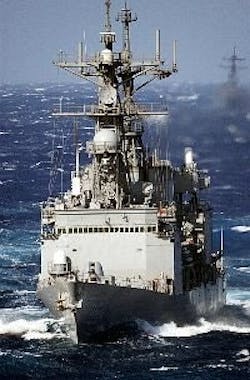When the Navy’s Self Defense Test Ship set sail from Port Hueneme, California, in December of 2009, it was under the control of RTP Corporation’s Critical Control and Safety Systems.
The Self Defense Test Ship (SDTS), formerly the USS Paul F Foster, is deployed to allow the Naval Surface Warfare Center to test the effectiveness of defensive systems designed to protect America’s ships and sailors.
In a typical test, weapons will be fired at a test barge pulled 150 feet behind the ship. The barge is equipped with defensive weapons which, if effective, protect both it and the ship pulling it. This constitutes the most realistic test of defensive weapons that will be deployed on American ships and is a vital step in assuring the safety of American ships and sailors.
Due to the ship’s proximity to the barge, it is imperative that it operate unmanned during the testing. Prior to its most recent conversion by HPI of Houston, Texas, the ship could be operated with limited mobility in this unmanned state. HPI and RTP have teamed to allow complete remote operation of the vessel.
The RTP Critical Control and Safety Systems will operate all aspects of the ship including controlling the 4 – LM2500 Turbines that provide propulsion and providing complete steering control including the control of two shafts with variable pitch propellers and rudder control.
HPI and the US Navy selected RTP due to its high reliability, its rugged construction, and RTP’s history of long-term support for its products. The complete RTP system consists of four (4) RTP 2500D redundant controllers and one (1) RTP2500S simplex controller controlling all aspects of the ship’s operation including steerage, shaft control, and the operation of the LM2500 turbines.
All of the systems communicate over RTP’s redundant SIL-3 rated 100 megabit host network.
HPI designed the system to replace the existing analog controls, creating a fully integrated remote control system allowing the SDTS to operate unmanned at sea. This control system allows shore based personnel to control the ship’s speed, course, and machinery during weapons drills.
About the Author
waltboyes
waltboyes

Leaders relevant to this article:
 You have heard a lot about UAVs since they've been widely used in the war in Afghanistan...unmanned aerial vehicles...but have you heard about UNVs?
You have heard a lot about UAVs since they've been widely used in the war in Afghanistan...unmanned aerial vehicles...but have you heard about UNVs?
